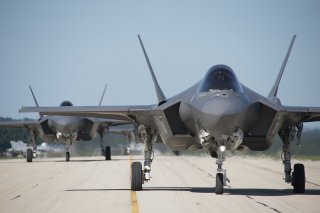The Pentagon Wants to Avoid Repeating Its F-35 Procurement Troubles
The Pentagon's proposal for its next batch of fighters upends conventional defense thinking.
Here's What You Need To Remember: For quite a long time the United States has justified its fighter aircraft projects on a combination of military necessity and military Keynesianism. Expensive fighters provide advanced military capability, but also provide jobs and investment across a broad swath of communities. The “New Century Series” proposal offers a dramatic organizational and technological solution to the problem of modern fighter acquisition. However, politics may offer the biggest obstacle. People want a new vision of fighter procurement because of the disasters associated with the F-22 and the F-35. Neither process generated a bad plane; the F-22 remains the world’s most dominant fighter, and the F-35 is coming along despite a long series of hiccups. But in both cases, the process generated a cascading series of political dilemmas that endangered the projects and created uncertainty for all the participants. This led to the cancellation of much of the Raptor buy and has turned F-35 acquisition into a political crisis in several different countries. Will Roper wants to avoid the circus while still capturing technological gains. He hopes to do so by using high technology means to separate the design process from the production process, thus breaking up the dynamic that has led to metastasizing fighter projects. Instead of a gargantuan F-35 buy, the U.S. would acquire small, artisanal batches of fighters, then move on to the next design as technology and the strategic situation shift. Fighter production would come to look more like the system that generates new iPhones or new Corollas than the system that has given us the Raptor and the Panther. Unsurprisingly for a proposal of such ambition, there are significant unanswered questions. The project seems designed specifically with the U.S. market in mind, and how it might work on the export market remains to be seen. If executed, this would have a transformative impact on the defense industry, and on the politics of defense acquisition. For quite a long time the United States (and most of the other Western democracies) has justified its fighter aircraft projects on a combination of military necessity and military Keynesianism. Expensive fighters provide advanced military capability, but also provide jobs and investment across a broad swath of communities. The F-35 exemplifies this, and in fact, internationalized it. Lockheed Martin designed the F-35 development and production process in order to make it invulnerable… to Congress. Producing the fighter around the country made it difficult for Senators and Representatives to justify killing it. Selling the F-35 around the world (and integrating international partners into the production process) provided a backstop by ensuring international pressure to keep the project going. Let there be no mistake: This is a bad process, both for aircraft development and for democracy. But it also seems to represent the only way that advanced democracies can convince their constituencies to cough up enough cash to pay for increasingly expensive aircraft. Projects like the Gripen, Rafale, and Typhoon differ in the details because of variations in the domestic political environment, but all increasingly depend on the domestic and international dispersal of production as a political survival tactic. The F-35 and its kin also emerged within a particular constellation of the defense industrial base. On the one hand, consolidation reduced competition for major contracts, and generally increased the size of defense firms. On the other hand, the demands of technology and supply chain management resulted in a major increase in subcontracting, with a bewildering array of firms producing components for final assembly. The big defense firms essentially became systems aggregators. On the labor side, the aviation workforce remained highly specialized and incredibly valuable, but the demands of complex technology pulled in a wider array of workers from different industries. Themselves politically powerful, these workers helped sustain the survival of the aircraft. Roper’s project seems destined to upend all of that. Separating design and production would seem to break the oligopolistic position of the big defense firms, although their expertise at systems aggregation would remain necessary. New firms could enter the market on either the design or production side, although this might require a new system of contracting at the Pentagon. This in and of itself would disrupt the methods of political management through which the big defense firms have historically protected their programs; Lockheed can no longer simply decide to locate facilities in certain strategically important states and districts in order to get political protection. Finally, the shift to smaller design and production bureaus could have unpredictable effects on the security of the labor force. In Roper’s vision, more fighters would be built, but some of the savings of the approach would be generated by reducing labor costs and shifting to automation. Reducing labor costs is great, of course, except for labor. This is all complex, dangerous thinking. And some suggest that it doesn’t really solve the big problems. As others have pointed out, some of the most serious financial problems facing the Air Force involve fleet maintenance costs rather than procurement costs, and this system would tend to increase rather than reduce that overhead. In a way, the proposal is reminiscent of President Obama’s efforts to reform the healthcare industrial complex, which generated far-reaching and often unexpected consequences. As Obama understood, cutting costs is great, except insofar as cutting costs necessarily threatens key actors (insurance companies, hospitals, labor) who operate in the healthcare field. Roper’s proposals may or may not be technically and technologically workable, but the political implications may end up being the most dangerous pieces of all. Dr. Robert Farley, a frequent contributor to TNI, teaches at the Patterson School of Diplomacy and International Commerce at the University of Kentucky. He is the author of the Battleship Book and can be found at @drfarls. This article is being republished due to reader interest. Image: Flickr.

